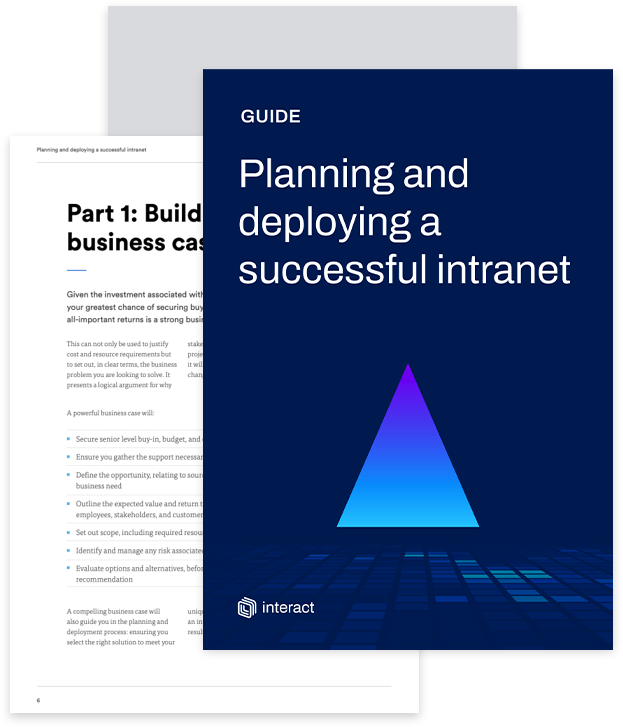When it comes to technology, we’re used to change. We expect – and even demand – regular updates, fresh features, and new releases. If it’s business software then these updates are even more important as they enable organizations to remain relevant. A company intranet must do the same — here’s how yours can.
When developers constantly chase the ‘next Big Thing’ they risk deviating from the original reason that a software tool exists in the first place. We can add as many bells and whistles as we like, but if the application doesn’t perform its core job, it’s doomed to fail.
When it comes to intranet software, Interact takes an agile approach to regularly reviewing, updating, and launching new features that will serve our customers. But there’s a balancing act. When deciding what to update or introduce to Interact, we need to identify if these ‘nice to have’ or on-trend features will actually support the core goals and requirements of a corporate intranet.
Here, we explore nine things a company intranet must do in order to provide value to a business – and the features and functionality that support those goals.
1. Help get work done NOW
In a recent customer survey, we looked at the reasons why people come to their company intranet. Reviewing feedback and data from the 1,000,000 users of our corporate intranet software, we’ve found three top reasons why users visit their intranet:
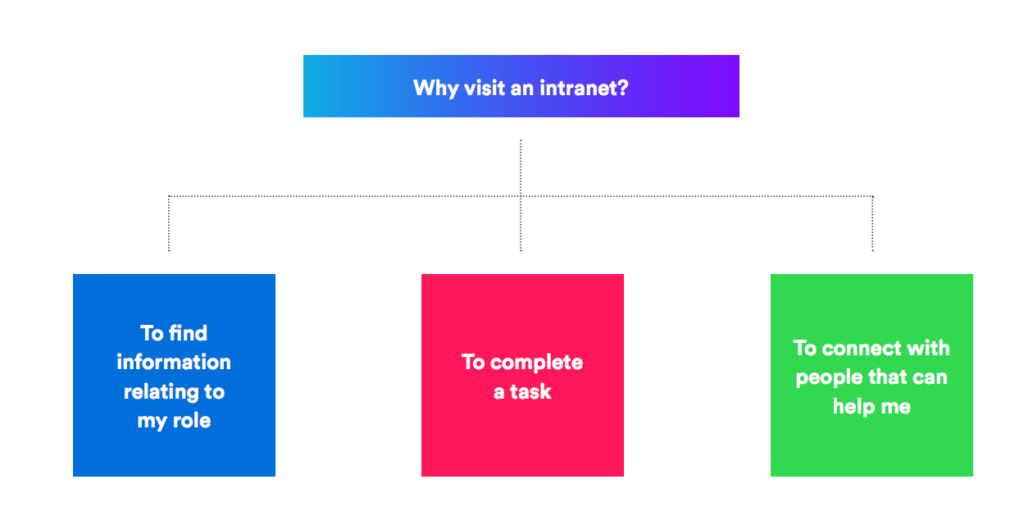
The common theme? They are all user-centric, and functional.
The simple fact is, people come to their organization to perform their roles and get work done. A company intranet should make this process more efficient and help users do their jobs.
When we look at this more closely, we can see that at the most basic level an intranet is there to help solve problems. Whatever the problem – the need to get expenses paid, to deal with a certain customer, to understand return to work benefits or find somebody that speaks Spanish – users should be able to go to the intranet and solve that problem.
Typically, these ‘problems’ or tasks tend to fall into one of 4 categories:

- Communication: to both receive top-down communications about their organization, team, or perhaps particular projects, and to communicate with others
- Information: for example, seeking out a Acceptable Usage Policy, company documentation, or perhaps policies and procedures required to fulfil their roles
- Collaboration: such as finding a colleague who can support on a particular task, or to team up with others on a project
- Business processes: for example, booking a leave of absence or submitting expenses
To serve its core purpose, therefore, intranet software needs a blend of tools that answer each of these categories, connecting users to the people, information and tools they need to solve problems as efficiently as possible.
Within Interact, these tools include:
- People directory and organizational chart: At the heart of every business is its people. Bringing together employees and enabling them to find and connect with one another is essential; a comprehensive People Directory that has the option to pull data from multiple sources, and to add rich information such as hobbies, interests, languages or qualifications, provides the answer.
Our intranet software also has the ability to add Profile Badges, which can be used to recognize achievements or highlight those employees with specific expertise and skills. A highly visual organizational chart supports this further by displaying work responsibilities and reporting relationships, showing users where they fit in the big picture.
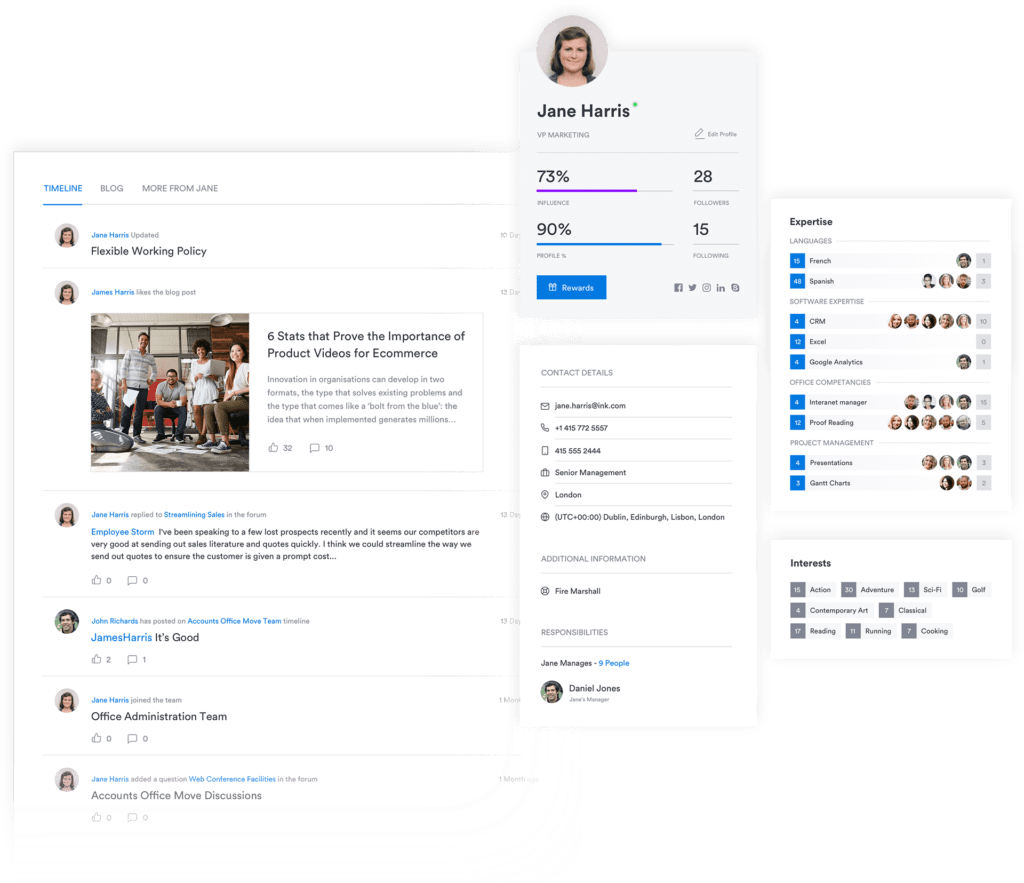
- Workflow and Forms: This tool empowers organizations to streamline critical business processes, such as submitting expenses, with automated workflows. A user-focused design means even non-technical people can create simple, easy-to-build forms: keeping that principle of efficiency, by removing the need for IT or a specialized intranet administrator.
- Integration functionality: our platform is a communication and collaboration tool. It can’t do every job within a business; nor should it try to. There is a large range of specialized tools and platforms available for different processes and functions; a successful intranet must bring these together in a centralized, streamlined way, acting as a gateway to the digital workplace.
Integration functionality allows a corporate intranet to become the ‘go to’ location for staff, who can then access all their essential tools, applications and platforms from one place, using a single login.
- Content Management System (CMS): an intranet isn’t a document management system; however, it is the center point for business information. The ability to upload, create and access different types of content with an easy-to-use CMS intranet is crucial.
Interact combines a simple and user-focused content management system with tools such as tagging, keywords, page findability scoring, and the ability to assign pages as a ‘Best Bet’ for particular search terms, ensuring the most relevant content appears at the top of search results. In addition, review dates and version control help keep all intranet content current and up-to-date.
- Enterprise search functionality: Putting the right content into the hands of employees by providing a powerful and comprehensive search across all your intranet content and cloud storage systems is key. If your users can’t find what they’re looking for, your intranet loses its relevance.
Get the most from your intranet
2. Focus on your USERS: getting the right content, to the right people, in the right format

Organizations are, by nature, diverse. While your company is a collective, it is also made up of individuals – each with unique roles, requirements, skillsets, and objectives to achieve.
So, when it comes to your intranet content strategy, it is critical to focus on user needs, rather than business needs alone. We also need to be conscious that what one user wants – or needs – isn’t what another user wants: there is a range of different communities within any organization, each looking to get something different from their intranet experience. Identifying the key stakeholders for your intranet, and their needs, is fundamental to its success.
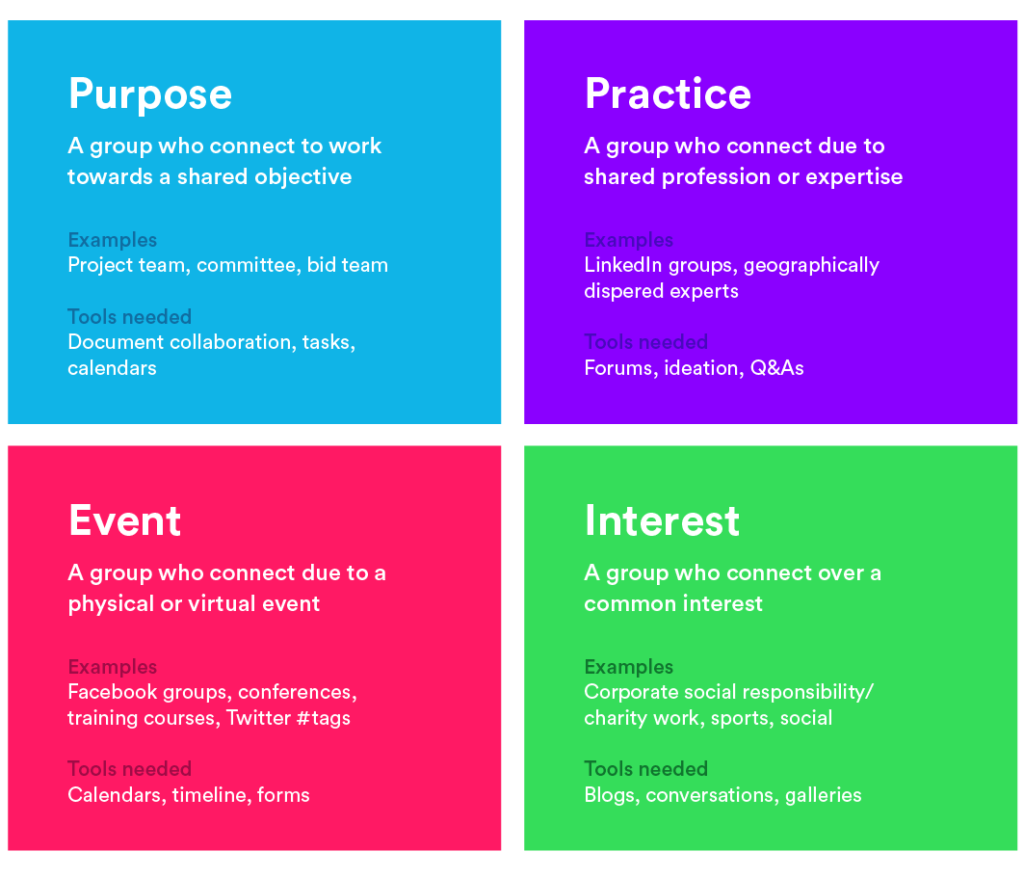
Here at Interact, we work hard to create a social intranet with a variety of tools to target relevant, timely, and useful content to users. This is why we have had such a high customer retention rate, and why our customers have such successful, award-winning intranets.
Our ethos is that ‘content should find people’. Content targeting and content personalization have both seen an increased focus in business communications in recent years and offer distinct approaches to getting the right content to the right people. As digital consumers, we now increasingly expect content to be pushed to us based on our unique browsing habits, individual demographic, our tastes, and interests. Amazon, Google, Twitter, and LinkedIn all do this – and so should your intranet.
Content targeting places audiences into defined segments, placed on a common attribute. For example, all employees from a particular regional office would be a segment; or perhaps all your new starters. This information can be pulled from user profiles using @mentioning, and content can then be targeted to that segment’s unique needs. Interact also offers a Persona Group feature that empowers organizations to create dynamic, multi-criteria groups of users to deliver truly targeted communication – for example, to send a training event alert to all staff who manage 2 employees or more, but haven’t completed Manager Training.
Tailored homepages with relevant information, widgets, and content for specific groups can also ensure those users have a personalized user experience from their intranet. For example, having new starters log into a purpose-built homepage for the initial weeks of employment will ensure they receive vital information relevant to them, and deliver greater value from the intranet.

Personalization, by contrast, focuses on the individual end-user. Using algorithms and machine learning, it sets out to understand real-time intent and respond by pushing content accordingly.
Interact can learn and analyze user behaviors and interactions with the intranet, using those insights to promote relevant content through suggestions, searches, and recommendations.
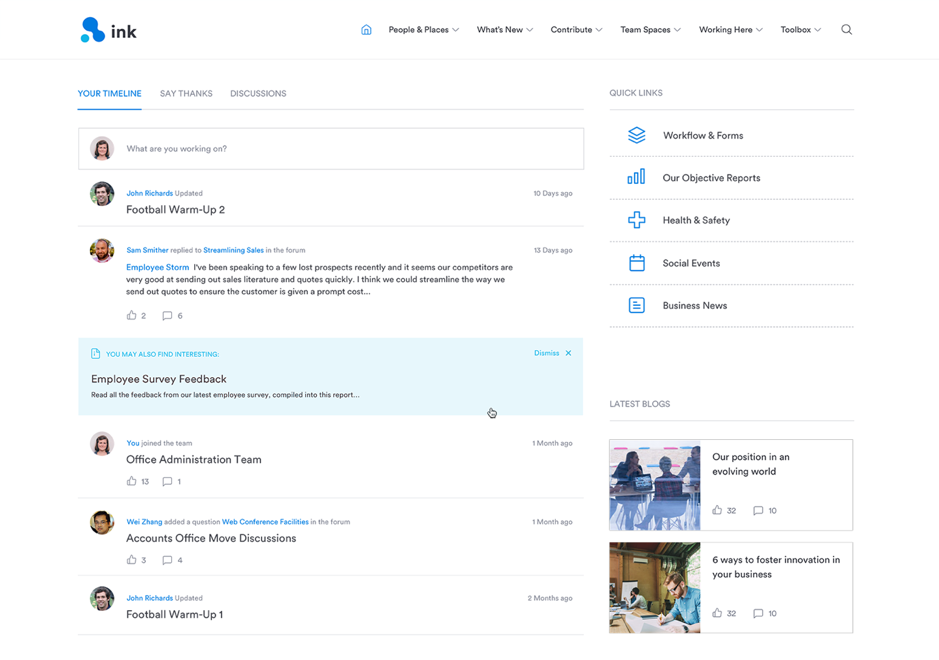
Targeting and personalizing content serves two purposes:
- It signposts content users may need to get work done based on previous habits. For example, if a user searches for a particular policy and someone else adds a related document to the intranet at a later date, the original user would be promoted that content through Interact Suggests.
- It helps to uncover content that the user may not know existed. Interact Recommends is a tool built to recommend content such as blogs, events, news, and people that somebody wouldn’t necessarily go searching for – but would find useful.
Takeaway: Have you considered the unique, individual needs of your users and the communities they form? Do you offer the right features, functionality, and capacity to tailor and personalize their intranet experience?
Get the most from your intranet
3. Align with your business objectives
We’ve talked about the need to focus on the end users of your intranet. However, it is equally important to ensure your intranet serves a strategic purpose within your organization.
It’s amazing how often we talk to business leaders in a company and discover that the objectives of their intranet aren’t aligned to the objectives of the business. Without this direction and alignment to your goals, your intranet won’t deliver value. If it doesn’t deliver value, it will soon slip off the management priority list – and at best become redundant, or at worst, removed from the business altogether.
It’s something we explore at length in our guide on building an intranet business case, but for now, ask yourself these simple questions. If you can’t answer them, it’s likely your intranet won’t benefit your company:
- What are your long-term, strategic objectives as a business, and what role could – or does – your intranet play in achieving those?
- Is your intranet aligned with the objectives of each individual business unit?
- How do you measure the success of your intranet? Do you have benchmarks in place to gauge ongoing performance?
- Do you have the buy-in of senior management for your intranet?
- Do you regularly review your objectives?
For example, if your strategic business goal is to expand internationally, does your intranet support a globalized workforce? Does it enable remote access, facilitate collaboration across different timezones, and offer the correct features and tools for different offices?
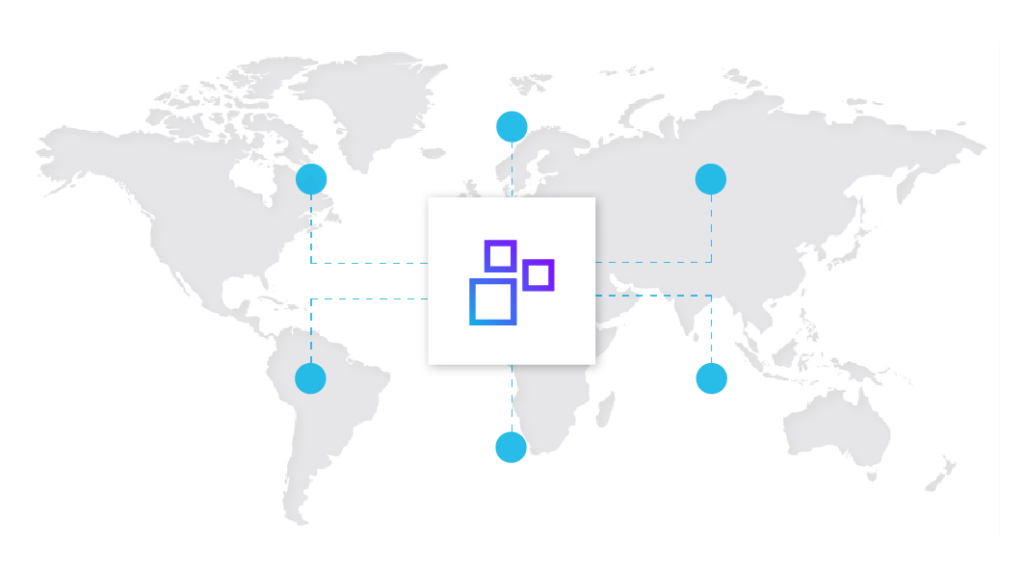
Or perhaps you are set to undergo a significant change. How can your intranet ease this transition for both management and employees? Will it enable you to communicate change effectively, maintain engagement, and ensure the culture and vision of your organization are upheld?
Whether you’re at the start of your intranet project or already have a legacy system in place, invest time in drawing that connection between wider business goals and the objectives for your corporate intranet. This will ensure it delivers a return on investment and continues to be a valuable tool for your business.
Takeaway: Your intranet is a business tool. Ensure it has defined objectives that align with your overall business goals and direction.
4. Focus on – and cater to – mobile and remote workforces

Mobile technology and remote working are now established in the business market. We can no longer argue that 20xx is the year of mobile working or Bring Your Own Device (BYOD): that time is already here.
People need to be able to work on whatever device they are on, wherever they are. Think about the needs of your company. What will people want to do on their mobile? How can we support them with completing work and tasks on the go? Will they be able to access vital information or applications without restriction, regardless of their location, device, or form of connection?
Then consider the tools they will need and provide those tools in a ‘mobile-first’ platform that works for them.
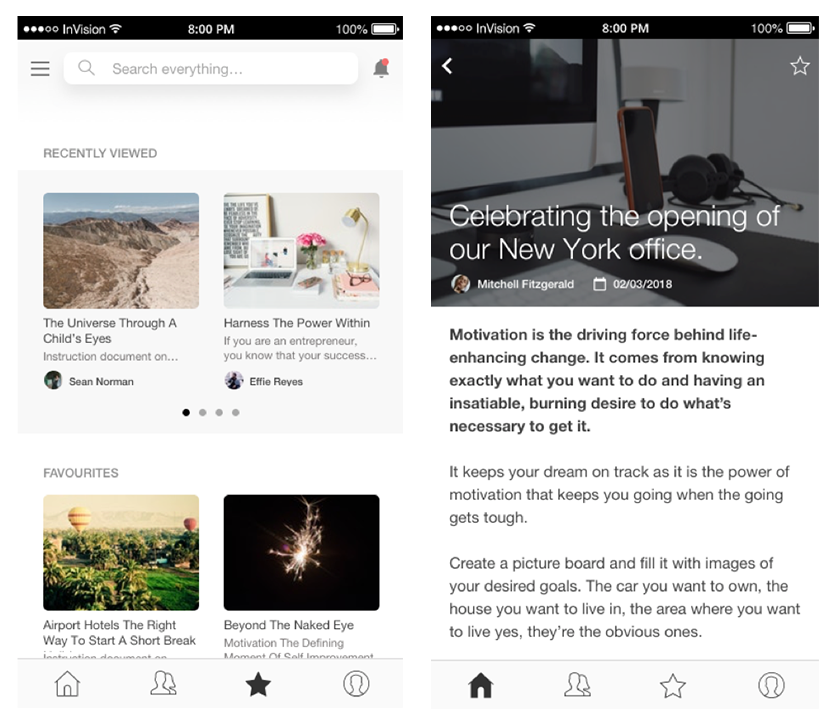
Interact is built to meet the needs and demands of all employees, regardless of location or device. Native mobile apps for iOS and Android ensure critical tools, contacts, and information are available without any compromise on functionality or user experience.
When employees are dispersed and hard to reach, whether on the shop floor, out on the road, or working remotely, reaching them during times of need or crisis is critical. Timely distribution of emergency protocols, confirming staff safety, and management of response efforts becomes increasingly tricky when you have a large workforce who aren’t office or desk-based.
Interact’s Broadcasts feature functions as an employee alert system to distribute urgent, point-in-time information across multiple channels during times of crisis.

A single message can be composed within the intranet and then distributed via SMS, push notification, email, a blocking notification within the intranet, and/or a display banner. This multi-channel approach, coupled with a confirmation that the message has been read/acknowledged and analytics to show who has read and received it, ensures the message gets out and helps save valuable time when it matters.
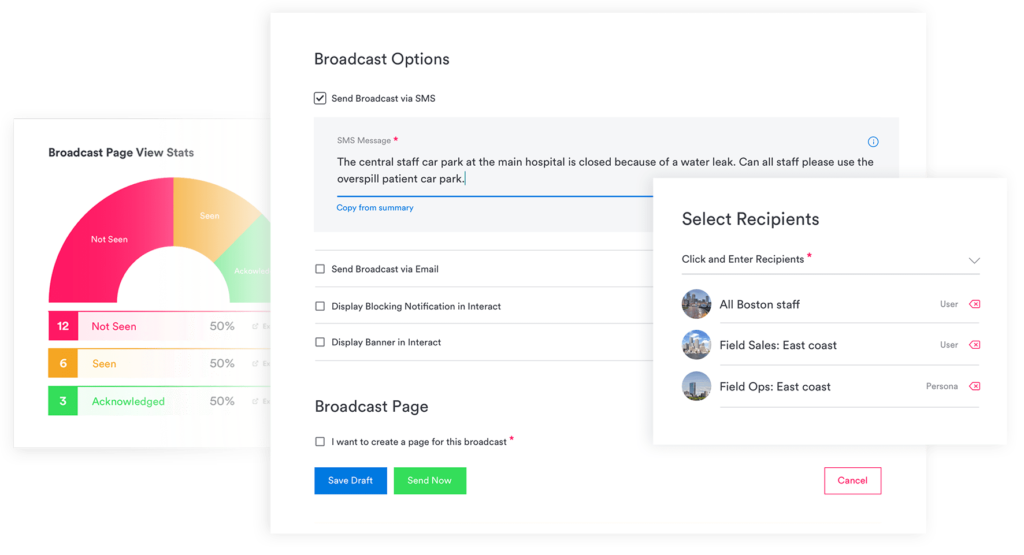
Takeaway: Workforces are becoming increasingly mobile. Ensure you are able to meet their needs and provide access to the essential tools and information they require to do their roles effectively, as well as reach them when it matters most.
Get the most from your intranet
5. Work at speed and deliver a great user experience
Your intranet is there to provide value to your employees; they are the consumer, the customer of your intranet. As such, they will expect the same level of performance from their intranet as any other web-based technologies they use, such as Facebook, LinkedIn, Twitter, and national news sites.
This means that both the speed of your intranet and the user experience (UX) should be something your users take for granted.
Often, intranet owners have the perception of ‘speed’ or ‘user experience’ as being about the time it takes to load a single page of your intranet.
Yes, loading speed is important. However, user experience goes much, much further than this. For example, does the structure of your information architecture and navigation allow users to quickly identify where they need to go? Is the taxonomy of content areas unwieldy, are there too many unnecessary clicks or is it difficult to get to the information they need?
One of the primary goals of any intranet is collaboration: giving your intranet to your users and getting them to engage and contribute. How easy is it for even non-technical users to create content? Is the interface intuitive and simple to use? Does it allow for different file formats – for example, enabling authors to upload Word, Excel, PDF files, and add images, videos, or links to their content?
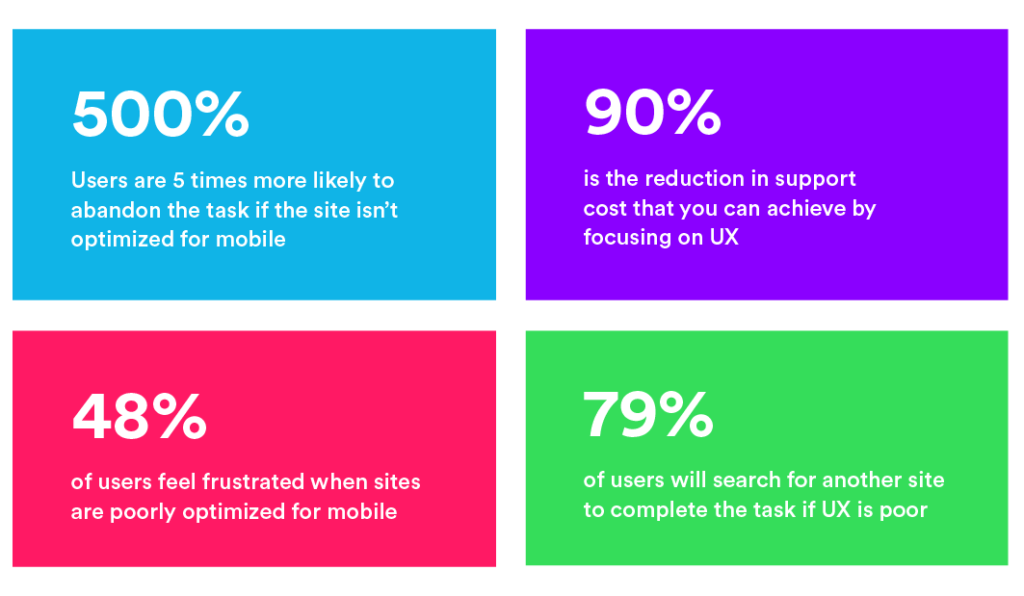
At Interact, the end-user experience is a primary focus in all development. We are committed to creating a fast, intuitive, easy-to-use platform that delivers a first-rate experience across all environments and browsers.
Takeaway: Put yourself into your users’ shoes. What is their experience of your intranet, its speed, accessibility, and ease of use? Is it easy for them to find what they need or complete tasks? Place user experience at the top of your priority list and invest in intranet strategy services to ensure you deliver.
6. Help create and embed a successful culture
Organizational culture, although an almost intangible concept, is now recognized as one of the most important aspects of a successful business.
According to research, 78% of CEOs/CFOs believe it is within the top five value drivers for a business; 91% believe improving corporate culture will increase an organization’s value.
However, in a digital age where many of our staff are dispersed across multiple offices, working remotely, out on the road, and connected almost exclusively by their devices, creating and communicating a collective culture is a huge challenge.
As the heart of your digital workplace, a corporate intranet has a huge role to play. This comes down to a number of elements:
- Brand and purpose: who are you, and what do you stand for? Employees increasingly look for purpose and meaning in their work. Using your intranet to communicate this is vital. Your intranet can be awarded its own internal brand to provide a sense of identity and instill pride or ownership among your users. Use it to promote and embed your mission and values, to communicate your CSR efforts, and to give insight into the different areas of the organization – perhaps through a ‘day in the life of’ series, or by putting the spotlight on different departments, regions, or campaigns.
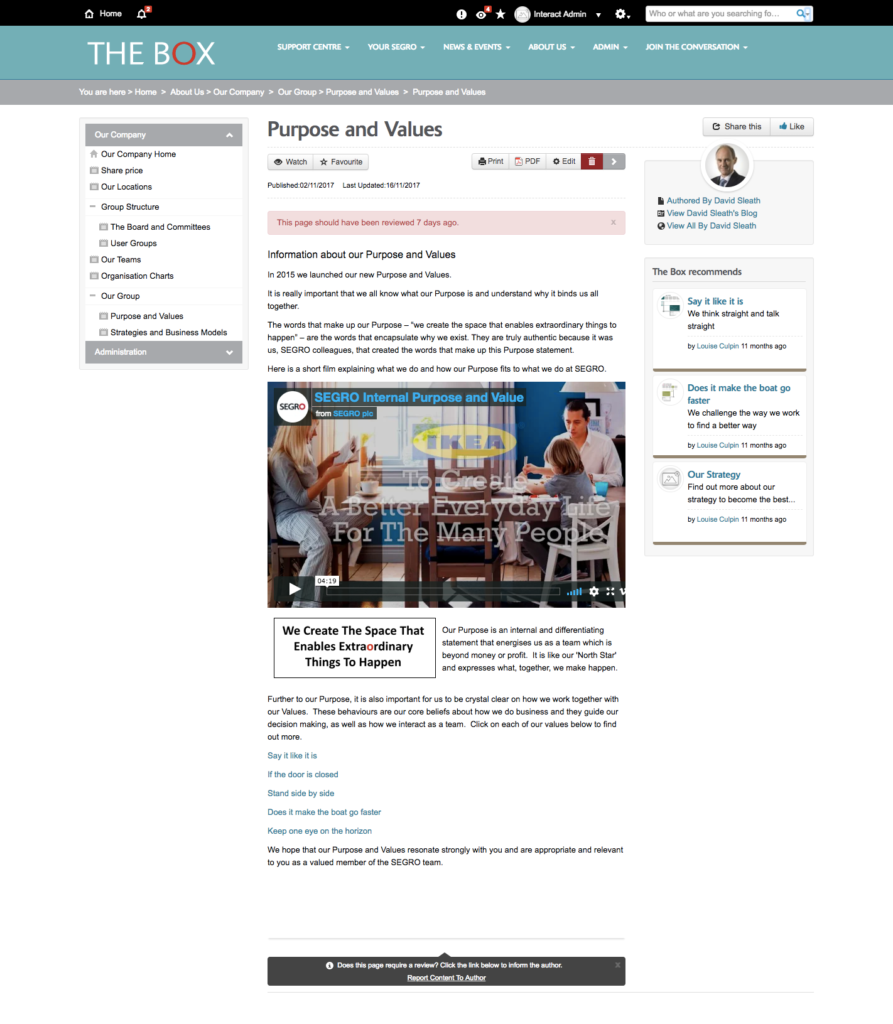
- Onboarding: those first few weeks in an organization can be make-or-break, and heavily influence a new recruit’s perception of their company and colleagues. Facilitate training, streamline the mandatory admin processes, connect recruits to their peers, and give insight into the culture with tailored new starter homepages.
- Reward and recognition: celebrating the success of both individuals and the business as a whole is a critical element of a positive culture. Interact Rewards empowers staff to give peer-to-peer recognition; use blogs or news for top-down recognition, ensuring staff feel valued and know how they’re contributing to the overall success of their organization.
- Share business news and direction: a successful culture is dependent on each individual contributing to shared goals and objectives. Help connect staff to the bigger picture with regular company updates, publishing of performance, and by communicating change.
- Leadership: one of the biggest influencers on corporate culture is those at the top. But what if your staff are based remotely, and never see or hear from their leaders? Use intranet blogs, vlogs, or news areas to give visibility to your organization’s leaders. Encouraging management to engage with staff – perhaps by liking, commenting, or replying directly to staff on the intranet – embeds that connection even further.
- Give staff a voice: two-way communication and empowering staff to be heard makes a huge difference to the culture of an organization. Use tools such as discussion forums, pulse surveys, commenting, and user-generated intranet content types such as blogs to help staff put forward ideas, feedback on suggestions, and raise any concerns.
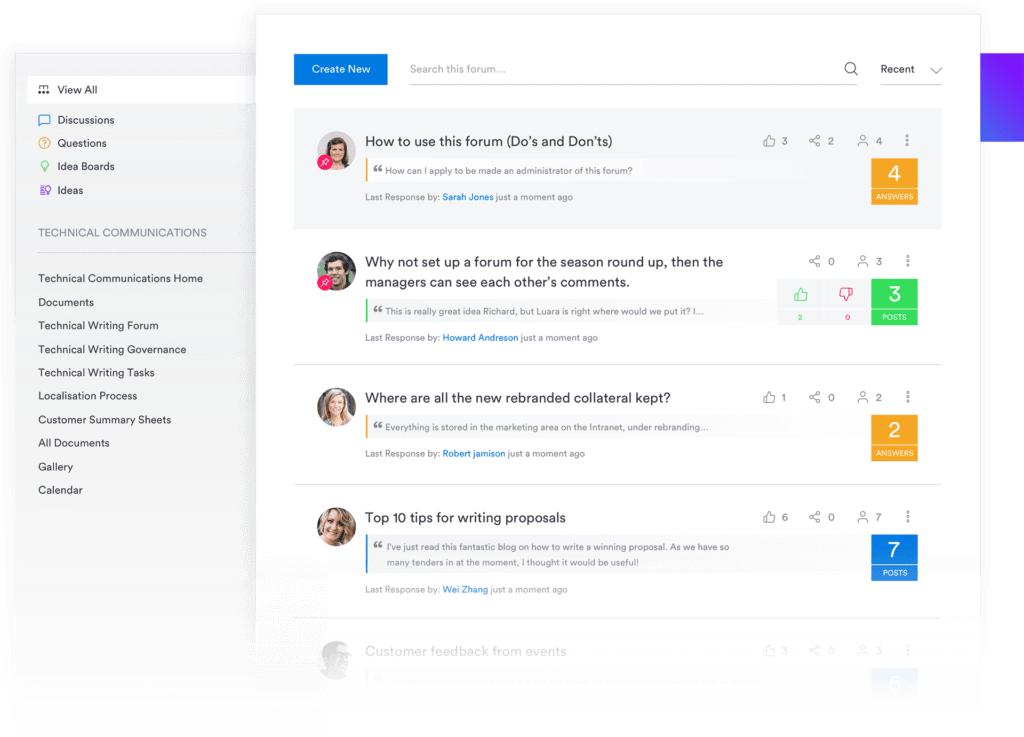
- Break down siloes: for remote or front-line staff in particular, work can be an isolating experience. Many may not engage with colleagues outside their immediate team and often feel disconnected from the organization as a whole. Interact Teams and a host of social features allow staff to connect outside their departmental silo. This may be through joining the company running team, for example, or perhaps posting Netflix recommendations on the discussion forum.
Takeaway: The diversity of tools available on an intranet presents endless possibilities for organizations to build virtual cultures that will translate to colleagues regardless of their role, location, or the nature of their work. It cannot build a culture by itself: but by fostering online communities and creating valuable connections, it can play a huge role in furthering your efforts. No other business platform can achieve this on the same scale.
Get the most from your intranet
7. Allow people to self-serve – decentralize your intranet
Employees are more confident with technology than ever. As a collaborative platform, an intranet is also ultimately for, and about, your employees. Give it to them by allowing them to build their own areas to collaborate, create forms, post or share content, add events, and more. Ultimately, enabling your people to self-serve is essential for intranet success.
Interact Communities has transformed the way many of our customers use their intranet by allowing people to create their own project spaces quickly and easily, with no IT involvement.

The important thing to remember is that ‘teams’ in the modern-day workplace are, by nature, agile and diverse. They are also always unique to each company. Organizational design has seen a shift away from ‘hierarchy’ structures to more collaborative, interlinked networks where roles, interests, and skills are moved to where they are needed.

This calls for a multitude of different spaces where groups can collaborate, communicate and complete business tasks – and can’t be defined by traditional role-specific teams. For example, you may have a team space linked to a particular project, or around a common interest or area of expertise.
Alongside this, our Workflow and Forms tools and integration functionality has enabled many business-critical processes to be automated, reducing the burden on internal resources by empowering staff to complete daily tasks, such as submitting expenses or booking a leave of absence, for themselves.
Intranet software that uses functionality users recognize from their day-to-day lives – for example, social features including @mentioning, #tagging, timelines, or commenting – can help instill confidence in the tech-shy user to get using the intranet.

Perhaps the most powerful means of decentralizing, however, is the one that links to creating a positive culture: user-generated content. Traditional internal communication models were top-down: management would create a message, and then broadcast it down to staff.
Now, we understand that two-way communication is crucial to a healthy workplace. A simple-to-use intranet with the right permissions can empower staff to create blogs, contribute to discussion forums, put forward ideas, comment on posts, vote in polls, and much, much more.
Takeaway: Encourage your users to take ownership of your intranet. Ensure you have a platform that is easy to use and allow employees to create their own collaborative spaces and content.
8. Serve as the heart of your digital workplace
The way we work has shifted dramatically over the past decade. We’re no longer tied to our desks in the office, working in a single country, or using just a handful of company-approved apps. Work is increasingly without boundaries, with practices such as remote working, globalization, and BYOD/BYOA now commonplace.
Working in this new digital workplace has its advantages. We can work from anywhere, at any time. We can choose our own apps and tools to suit our needs. We can connect with colleagues across the boundaries of timezone or location.
However, this is a landscape that also comes with challenges.
Our technical ecosystem has exploded in growth. There’s an app for everything; and with the luxury of choice comes a disjointed digital experience. If my organization lacks a sales and marketing portal, my Sales Team uses email but my Marketing Team prefers Slack, and IT is advocating Microsoft Teams, what happens to communication in my business?
With an abundance of cloud storage options, how do I prevent my business knowledge and information from being locked into numerous siloes or duplicated over different platforms? If staff are using their own apps or devices to get work done, how do I ensure our data is secure?
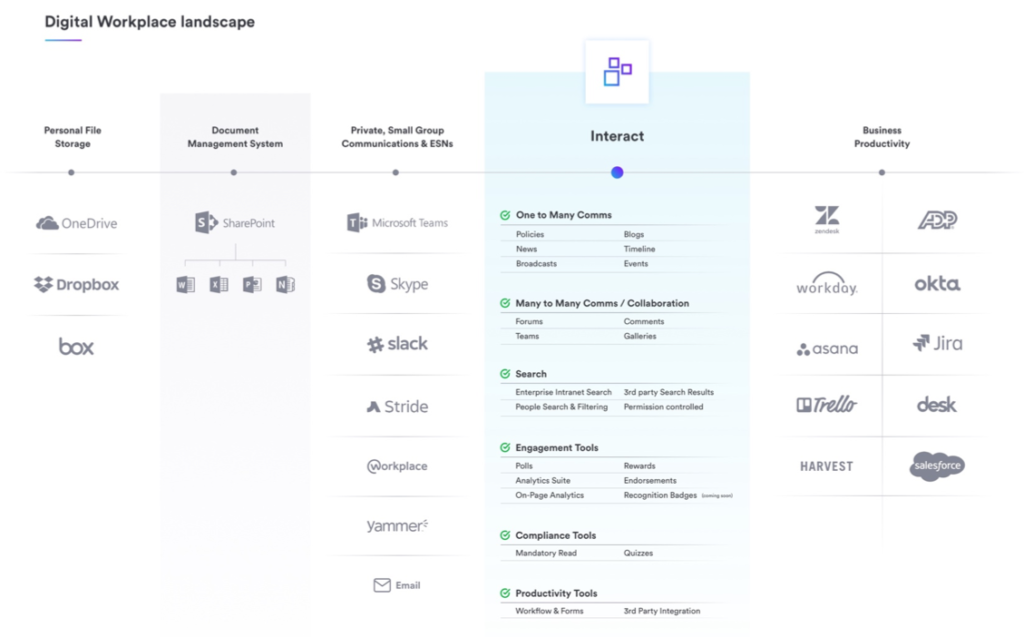
With integration functionality, authentication capabilities such as Single Sign-On (the practice of using your intranet to sign into third-party applications, with users logging in once with a single set of credentials to access multiple systems), enterprise search, mobile access and an employee-focused approach to design, the intranet can provide a solution.

By providing a gateway into your organization’s numerous tools, platforms, and applications, your intranet can be the much-needed ‘connector’ that unites that disjointed digital workplace. If employees can log in once to a branded, easy-to-use platform and from there access all the people, tools, and information they need, it has a huge impact on the employee experience.
“The intranet of today is seeing a new lease of life. Now, the intranet it not only relevant – it is a critical and integral element of any successful digital workplace.”
Simon Dance, CEO, Interact Software
9. Keep evolving and growing with your business
Investment in workplace tools and technology optimization has exploded in recent years. In particular, the collaboration and communications market has grown massively.
In turn, intranets have been the focus of substantial innovation and growth. In an age of enterprise social networking, cloud storage, and instant messaging, we’ve been asked whether intranets are still relevant and what role they can – or should – play in business communications.
Let’s consider what, at its most basic level, an intranet is.
An intranet is a powerful enabler to solve an employee’s need, offering timely and relevant information and support. It helps connect individuals, regardless of timezone, location, or device. It empowers employees with a voice and offers a means to tap into the knowledge of an organization. What’s more, in an increasingly challenging and dispersed workplace, it helps build and support a successful business culture.

Given the trend towards greater digital collaboration and the value placed on employee engagement, we would argue intranets are now more relevant than ever.
But, while the core role of the intranet has undeniable value, it can’t afford to be complacent in the fast-paced technological world we live and operate in today. To remain relevant, it must continue to grow with your business.
This responsibility lies not only with the developer, who must stay a step ahead of trends in business communication and technology as a whole – looking at the evolution and introduction of cutting-edge functionality including bots, AI, live streaming, and more – it also lies with the individual business. Re-visiting your intranet objectives and performance, evaluating that against your overall business goals and continually striving to improve, adapt and change your intranet in line with the needs of your organization is critical.
Takeaway: There are a huge variety of tools and applications available to facilitate communication and collaboration. The intranet is a collective, a facilitator, an employee portal that brings together all these different tools, features, and applications. In today’s marketplace, it is more relevant and valuable than ever. However, selecting a corporate intranet partner who will continually innovate and regularly re-visiting your objectives is crucial to continue delivering value.
